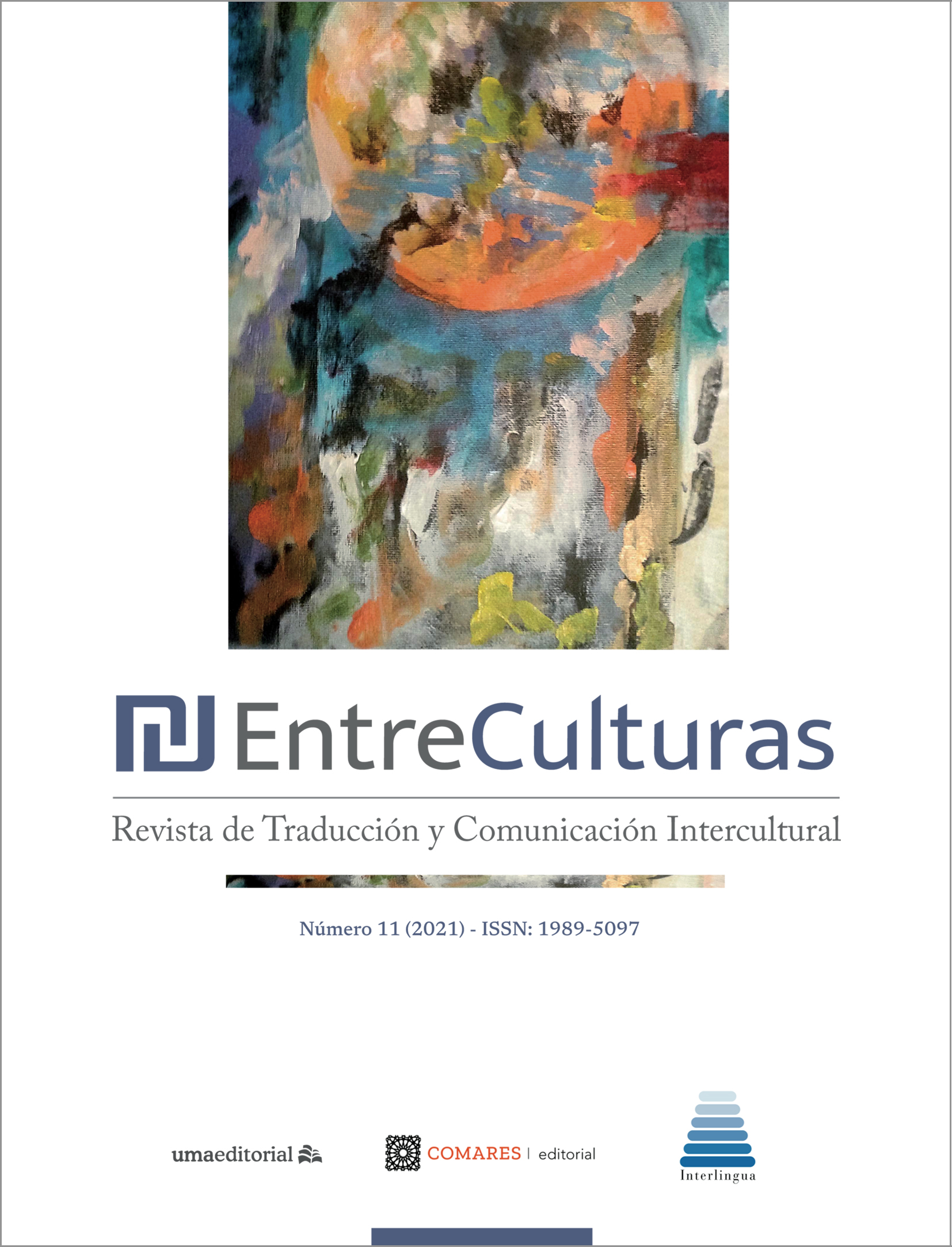The “Travelling” Memory between Identity and Translation
DOI:
https://doi.org/10.24310/Entreculturasertci.v1i11.12103Keywords:
Cultural memory, translation, identity, ipseity, alterityAbstract
One of the main characteristics of memory is its being in motion, which crosses in a transversal way: nations, eras and technologies. It is also one of the most important aspects in the identity construction; defines and punctuates the life of an individual or social group, indelibly characterizes them over time, is re-mediated within the media and the different groups of our society. His transnational "journey" that travels through space, time and technologies in continuous mediation and redefinition is assimilated to the translation. It is undeniable how memory, identity and translation are intimately connected with each other and with what is enclosed in the human essence, which must be understood in a dialectic of implication and ipseity/Alterity.
Downloads
Metrics
References
Betancourt Echeverry, Dario (2004): «Memoria individual, memoria colectiva y memoria histórica: lo secreto y lo escondido en la narración y el recuerdo» in La práctica investigativa en ciencias sociales, Bogotá, UPN, pp.123-134
Biau, G., José, R., & Pym, Anthony (2006): «Technology and (a pedagogical overview)», in Pym, Perekrestenko, Starink (Eds.), Translation Technology and its Teaching. Tarragona: Intercultural Studies Group, Tarragona, Universitat Rovira i Virgili, pp.5-21.
Bollettieri Bosinelli, Rosa Maria e Torresi, Ira (2012): «Messaggi in bottiglia: tradurre memoria, memorie della traduzione», in Arigoni, Mirella (Ed.) Memoria lingua traduzione, Milano, FrancoAngeli, pp. 17-27.
Bolter, J. David, e Grusin, Richard (1999): Remediation. Understanding New Media, Cambridge Massachusetts, MIT Press.
Bowker, Lynne (2002): Computer-aided Translation Technology: A Practical Introduc- tion, Ottawa, University of Ottawa Press.
Callmann-Lévy, Paris, trad. it. Iannotta D. (1997): La critica e la convinzione, Jaca Book, Milano.
Chesterman, Andrew (2006): «Questions in the sociology of translation. » in Ferreira Duarte, João/Assis Rosa, Alexandra/Seruya, Teresa (eds.), Translation Studies at the Interface of Disciplines. Amsterdam: Benjamins, pp. 9-27.
Chesterman, Andrew (2009): «The Name and Nature of Translator Studies». Hermes: Journal of Language and Communication Studies, 42, 13–22.
Christensen, Tina Paulsen (2011): Studies on the mental processes in translation me- mory-assisted translation. The state of the art”. trans-kom. Zeitschrift für Transla- tionswissenschaft und Fachkommunikation 4 (2): 137-16
Ciaramelli Fabio (1991): Ipseità, alterità e pluralità. Nota sull’ultimo Ricoeur, in «Aut Aut», 212, pp. 91-103.
Committee on Culture, Youth, Education, Media and Sport (2003): Report on Cultural Industries, Strasbourg: European Parliament, 14 July.
Cronin, Michael (2006): Translation and identity. Routledge. London
Dam, Helle, Karen Korning Zethsen (eds). (2009): «Translation Studies: Focus on the Translator», Hermes: Journal of Language and Communication Studies, 42, pp. 7-12.
Erll, Astrid (2011): Travelling memory. Parallax, 17(4), 4-18.
Halbwachs, Maurice (2001): La memoria collettiva, tr. di P. Jedlowski e T. Grande, Milano Unicopli.
Holmes, James S. (1988): «The Name and Nature of Translation Studies», in Holmes, J.S., Translated! Papers on Literary Translation and Translation Studies. Amsterdam: Rodopi, 67-80. Reprinted e.g. in Venuti, L. (ed.) 2000, The Translation Studies Reader. London: Routledge, pp. 172-185.
Mair, Christian (1992): «A methological framework for research on the use of nonstandard language in fiction». AAA: Arbeiten Aus Anglistik Und Amerikanistik, vol. 17, no. 1, pp.103–123.
Molano, Olga Lucía (2007): «Identidad cultural un concepto que evoluciona.» Revista opera, 7, pp. 69-84.
Muñoz Martín, Ricardo (1995): Lingüística para traducir, Barcelona, Teide, pp. 5-42.
Norman, Donald Arthur (1997): La caffettiera del masochista. Psicopatologia degli oggetti quotidiani, Firenze, Giunti (ed. orig.1988).
Peverati, Costanza (2014): «Le memorie come supporto alla traduzione. Aspetti socio-professionali e didattici», in Agorni, Mirella (ed.), Memoria, Lingua e Traduzione, Milano, Franco Angeli, pp. 41-72.
Pym, Anthony (2003): Redefining translation competence in an electronic age. In defence of a minimalist approach. Meta: journal des traducteurs/Meta: Translators' Journal, 48(4), 481-497.
Pym, Antony (2009): «Humanizing Translation History», in Hermes: Journal of Language and Communication Studies, 42, pp. 23-49.
Ribas López, Carlota (2007): Translation Memories as Vehicles for Error Propagation. A Pilot Study. Minor Dissertation. Tarragona: Universitat Rovira i Virgili.
Rigney, Ann (2005): «Plenitude, scarcity and the circulation of cultural memory», Journal of European Studies 35 (1), pp.11-28.
Simeoni, Daniel (1998). «The pivotal status of the translator's habitus», in Target. International Journal of Translation Studies, 10(1), York, University of Toronto, pp. 1-39.
Troisi, S. Cristian (2020): «Le mille notti di Hotensia Romero», in Estudios interdisciplinares en traducción literaria y literatura comparada, Granada, Comares.
Tyulenev, Sergey (2014): Translation and Society. Londres: Routledge.
Vallespir Soler, Jordi (1999) «Interculturalismo e identidad cultural.», in Revista Interuniversitaria de formación del profesorado, 36, Universidad de Murcia, pp. 45-56.
Vansina, Jan (1985): Oral Tradition as History. Madison, U of Wisconsin P.
Wožniak, Monica (2009): «Tradurre la memoria culturale codificata nel lessico:(molte) domande e (poche) risposte», in Tempo e memoria nella lingua e nella letteratura italiana, Atti del XVII Congresso A.I.P.I, Bruxelles.
Downloads
Published
How to Cite
Issue
Section
License
All contents published in Entre culturas. Revista de traducción y comunicación intercultural are protected under the Creative Commons Attribution-NonCommercial-ShareAlike 4.0 International (CC BY-NC-SA 4.0) license. All about this license is available in the following link: <http://creativecommons.org/licenses/by-nc-sa/4.0>
Users can copy, use, redistribute, share and exhibit publicly as long as:
- The original source and authorship of the material are cited (Journal, Publisher and URL of the work).
- It is not used for comercial purposes.
- The existence of the license and its especifications are mentioned.
There are two sets of authors’ rights: moral and property rights. Moral rights are perpetual prerogatives, unrenounceable, not-transferable, unalienable, imprescriptible and inembargable. According to authors’ rights legislation, Entreculturas. Revista de traducción y comunicación intercultural recognizes and respects authors moral rights, as well as the ownership of property rights, which will be transferred to University of Malaga in open access. The property rights are referred to the benefits that are gained by the use or the dissemination of works. Entreculturas. Revista de traducción y comunicación intercultural is published in an open access form and it is exclusively licenced by any means for doing or authorising distribution, dissemination, reproduction, , adaptation, translation or arrangement of works.
Authors are responsable for obtaining the necessary permission to use copyrighted images.





7.png)
